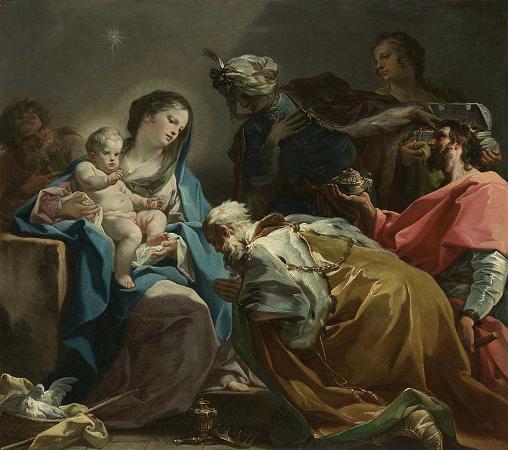Rococo Painting. Rococo, less commonly roccoco or Late Baroque, is an exceptionally ornamental and theatrical style of architecture, art and decoration which combines asymmetry, scrolling curves, gilding, white and pastel colors, sculpted molding, and trompe l'oeil frescoes to create surprise and the illusion of motion and drama. It is often described as the final expression of the Baroque movement. The Rococo style began in France in the 1730s as a reaction against the more formal and geometric Style Louis XIV. It was known as the style rocaille, or rocaille style. It soon spread to other parts of Europe, particularly northern Italy, Austria, southern Germany, Central Europe and Russia. It also came to influence the other arts, particularly sculpture, furniture, silverware and glassware, painting, music, and theatre. The word rococo was first used as a humorous variation of the word rocaille. Rocaille was originally a method of decoration, using pebbles, seashells and cement, which was often used to decorate grottoes and fountains since the Renaissance. In the late 17th and early 18th century rocaille became the term for a kind of decorative motif or ornament that appeared in the late Style Louis XIV, in the form of a seashell interlaced with acanthus leaves. In 1736 the designer and jeweler Jean Mondon published the Premier Livre de forme rocquaille et cartel, a collection of designs for ornaments of furniture and interior decoration. It was the first appearance in print of the term rocaille to designate the style. The carved or molded seashell motif was combined with palm leaves or twisting vines to decorate doorways, furniture, wall panels and other architectural elements. The term rococo was first used in print in 1825 to describe decoration which was out of style and old-fashioned. It was used in 1828 for decoration which belonged to the style of the 18th century, overloaded with twisting ornaments. In 1829 the author Stendhal described rococo as the rocaille style of the 18th century. In the 19th century, the term was used to describe architecture or music which was excessively ornamental. Since the mid-19th century, the term has been accepted by art historians. While there is still some debate about the historical significance of the style, Rococo is now often considered as a distinct period in the development of European art. Rococo features exuberant decoration, with an abundance of curves, counter-curves, undulations and elements modeled on nature. The exteriors of Rococo buildings are often simple, while the interiors are entirely dominated by their ornament. The style was highly theatrical, designed to impress and awe at first sight. Floor plans of churches were often complex, featuring interlocking ovals; In palaces, grand stairways became centrepieces, and offered different points of view of the decoration. The style often integrated painting, molded stucco, and wood carving, and quadratura, or illusionist ceiling paintings, which were designed to give the impression that those entering the room were looking up at the sky, where cherubs and other figures were gazing down at them. Materials used included stucco, either painted or left white; combinations of different colored woods; lacquered wood in the Japanese style, and ornament of gilded bronze. The intent was to create an impression of surprise, awe and wonder on first view. Rococo was also influenced by chinoiserie and was sometimes in association with Chinese figures and pagodas. The Rocaille style, or French Rococo, appeared in Paris during the reign of Louis XV, and flourished between about 1723 and 1759. The style was used particularly in salons, a new style of room designed to impress and entertain guests. The most prominent example was the salon of the Princess in Hotel de Soubise in Paris, designed by Germain Boffrand and Charles-Joseph Natoire. The characteristics of French Rococo included exceptional artistry, especially in the complex frames made for mirrors and paintings, which sculpted in plaster and often gilded; and the use of vegetal forms intertwined in complex designs. The furniture also featured sinuous curves and vegetal designs. The leading furniture designers and craftsmen in the style included Juste-Aurele Meissonier, Charles Cressent, and Nicolas Pineau. The Rocaille style lasted in France until the mid-18th century, and while it became more curving and vegetal, it never achieved the extravagant exuberance of the Rococo in Bavaria, Austria and Italy.
more...














